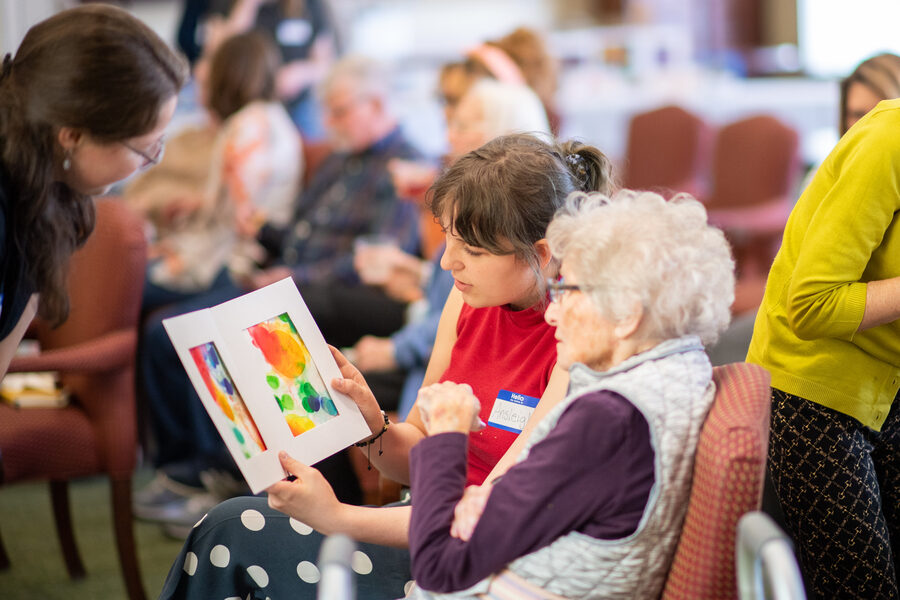Art and aging
For more than 15 years, Anne Mondro, an associate professor at U-M’s Stamps School of Art & Design, has been creating and facilitating art programs for people living with dementia in Michigan.
According to the Michigan Department of Health and Human Services, Michigan is currently home to 240,000 individuals with Alzheimer’s dementia — a term used to describe those in the dementia stage of the continuum. This number is expected to increase as the baby boom generation continues to age.
A crisis on a global scale, the disease also comes with a set of deep societal stigmatizations — myths that Mondro has been working to change in order to encourage quality of life, care, and dignity for people living with memory loss.
Building a vision
After years of partnering with the U-M Geriatric Center & Institute of Gerontology Silver Club on various projects, in 2014 Mondro decided to share her training with students in the form of a course titled Memory, Aging & Expressive Arts. The class pairs Stamps students with local community members living with memory loss to work together to build a vision around a creative concept, execute that concept together, and exhibit their work at the end of the term.
Her most recent class brought students to Brecon Village in Saline, Mich., where EHM Senior Solutions partnered with her to offer a 10-week program on Fridays during the winter semester.
 “This project really sticks with these participants, it’s really meaningful,” says Ryan Olson, adult day program manager at Brecon Village.
“This project really sticks with these participants, it’s really meaningful,” says Ryan Olson, adult day program manager at Brecon Village.
For the first half of the class, students and program participants were introduced to various forms of expressive art practices led by professionals in the field, including artmaking, storytelling, music, and movement. The last half of the class prompted students to create and facilitate an idea for a project based on the specific needs, abilities, and interests of the participants with whom they were partnered.
Cass Carpenter, a May 2019 Stamps graduate, had many conversations with her partner before settling on a final project.
“She talked a lot about spring — apparently she was an avid gardener when she was younger, so I put together a project where we’re painting flowers and other spring scenes,” she says. “I’m really making sure that she gets to make all of the decisions and does a majority of the work, and I’m making sure that we’re set up to be able to be proud of our project and finish it on time.”
Life lessons

Mondro’s Stamps students work on a movement activity with participants at Brecon Village in Saline, Mich. (Image: Eric Bronson, Michigan Photography.)
“I took this class, in part, to learn a little bit more about my grandfather, who is living with Alzheimer’s,” says Ansleigh Hamilton, a junior in the Stamps School, who worked on a music-based songwriting project with her partner. “What I learned is that the social aspect of the making is just as important as the act of making itself. Taking time with my partner to work toward a common goal inspires how I might approach a relationship with my grandfather in the future.”
An artist whose studio practice draws deep inspiration from relationships, interconnectedness, vulnerability, and strengths between people, Mondro encourages Stamps students toward thoughtful, genuine relationships with their collaborators.
“When I started out working with this community, the best advice I was given was this: when you meet one person with memory loss, you’ve met one person,” Mondro says. “You have to get to know the individual and meet them wherever they’re at.”
Mondro asserts that it’s important for individuals with memory loss to participate in activities that help them sustain their citizenship in joyful, meaningful ways: gardening, going for a walk, listening to music, making art.
“We focus on creating experiences that embrace being in the moment,” Mondro says. “Just because someone has memory loss doesn’t mean that you can’t enjoy life — that’s what really matters. That’s what we teach in this class.”
(Top image: Stamps junior Ansleigh Hamilton works with her partner at Brecon Village. Image: Eric Bronson, Michigan Photography.)
Read more Stories of Our State.
Read more stories about arts and culture at U-M.




Andrea Tembreull - Husband in 1992
Very nice story! Would like to see some of the artwork. 🙂
Reply
Sydney Hawkins
Here are a few more photos if you’re interested. If you click the small arrow on the right side of the photo, it allows you to scroll through the photos: https://www.instagram.com/p/B0Q3sebhaqb/
Enjoy!
Reply
Tom Willis - 2000
Love this simple idea: Just because someone has memory loss doesn’t mean that you can’t enjoy life
Reply
Gwendolyn Copeland - 1973
Thank you. This article supports my continuing belief that the more I know about my generation and possible oncoming health issues, the better prepared I am for them.
Reply
Gary Seldon - 2001
An excellent program combining the Arts and students with senior citizens with memory issues.
Reply
Howard Prager - 1980
This is a great concept and hope it expands. What it needs to include is the importance of one on one contact and touch through all of this and the value of creating connections is as important as the art itself.
Reply
Nancy Serlin - 1969, BA, 1976, M. Ed.
I think this is an absolutely phenomenal program you have started at U of M. As my mother passed away from Alzheimer’s a few years ago, I can see that what you are doing helped her greatly. I found that music and doing art were very very helpful to her. Although she couldn’t name any of the songs, she knew every word to every song. She was an actress and a singer so I am not surprised.
I am a baby boomer and approaching that age, so thank you for having a program that might help me someday .
Reply
Michelle Sider - 1981 BFA. 1989 PhD Clinical Psychology- U of D
I enjoyed your article. The arts are a “door” to one’s inner life. As both an artist and psychologist, I have worked with students and patients ranging in ages from 5-89 and have found the arts to be an alternate language for expression. Especially when words can fail one, art is there as a rich and beautiful means for expression. I recently coauthored and illustrated a book “Never Long Enough” by Rabbi Joseph Krakoff and Dr. Michelle Sider in which we use prose and imagery to help people deal with the end of life and loss of a loved one. Since our book relies so heavily on imagery, it has been very well received by those who have memory and language issues. In our second book, we created opportunity for coloring, drawing and expression. It has been quite moving to see how both the making and experiencing of art unlocks feelings, and is a means of expression and connection between people of all ages and ranges of cognitive ability. I would like to connect with Dr. Mondro. Thank you for your article.
Reply
Adrienne Kaplan
Does Michigan Today have a permanent art critic?
Reply
Deborah Holdship
No.
Reply
MaryJane Miller - 1982 MPH in Nutrition
My mother is 90 years old and has memory loss. She was in Independent Living for 5 years and really enjoyed it the first 3 years, probably due to an older next-door neighbor who was very assertive, had much initiative and got my mom downstairs to many of the programs, particularly daily exercise, music, and bingo. They also went on a lot of bus trips. It was my mom’s first time living on her own. It helped my mom a lot because the year before she moved into this senior residence, her husband and youngest adult child had died within 6 months of each other.
When mom’s neighbor died, she spent the next 2 years mostly in her apartment and sleeping. Her memory decreased and she became an eloper. The facility wanted to put her in their Memory Care Unit but my brother moved her up to his house. Not always so good. Wish she had a program like this or wish my adult niece and nephew who are caring for her would be more creative like your program, using art and music and animals.
Thanks for what you are doing.
Reply
Daniel Andrews - J.D. U-M Law, 1965
Editors: Sadly my dear wife of some 52 years (Bonnie Strehle Andrews,B.A, U-M, 1966), was diagnosed with Alzheimer’s Disease in 2011. In 2015, it reached the point where I was no longer able to care for her at home, and she spent the last 3+ years of her life in an incredible skilled nursing care facility receiving the 24/7 care and attention she needed and deserved before succumbing in May, 2018. For years, she had been an artist in stained glass; participated in a number of very large craft shows in S.E. MI, creating and selling 3-dimensional stained glass houses and other buildings. She not only replicated the home she grew up in, and the church that she attended as a child, and the home our kids grew up in in Plymouth, MI; but when our daughter attended the College of William & Mary in Colonial Williamsburg, VA., she replicated any number of the historic buildings there as well. During the course of her “journey” with A.D., however, she lost her ability to produce these treasures, along with the loss of other basic living skills. But I am also very much aware of the need for such programs as you describe. Here in Florida, the numbers are even more devastating than in MI. It is estimated that we now have 550,000 reported cases of A.D. involving nearly twice that many caregivers. It has reached pandemic proportions not only in Fla. & MI and the nation, but throughout the world. It was a death sentence when my wife was diagnosed, and it is still a death sentence today. Anything that can be done to address this disastrous disease, whether it be promotion of programs such as you describe or the needed advances in the medical response to this disease are most necessary. Thank You!! Most Sincerely, Daniel J. Andrews, Esq. (Ret.)
Reply
Jane Crabill - 1968
I love the thought and compassion behind this program. I’m sure the university students who participate get a great deal of inspiration and satisfaction from their endeavors,
Reply
Sandra Gommel - 1962
I realize the time was short for the students to work with the residents of Brecon Village, I wonder if there was any indication that the course of dementia’s progress slowed by the end of the students term?
Reply
Karen Walker
Loved your article! My daughter is a Recreational Therapist and works in a memory care facility. She loves working with patients every day — cooking, gardening, group exercise, art, music, games for memory stimulation, running social events and outings. This is such an important role! Loved hearing about how you’re sharing your art skills to allow dementia patients to stay creative and feel alive.
Reply
Susan S . Aaron - 1962
College of Architecture & Design -my family walked this walk with my brilliant father-Manuel L. Stillerman MD. Dad was an internationally recognized pediatric neuro ophthalmologist , significant WW II Surgeon, and gifted concert violinist. Dealing with the “Swiss cheese” nature of his Alzheimer’s was challenging. I’m more than happy to share our journey with others. Delighted to know U-M Stamp is active, buzz me! There are lots of great stories that can help others. Taubman has my contact info.
💛💙
Reply
Patrick Cardiff - 1990
My dad has dementia, and I have been searching for techniques to make us both enjoy interaction. I printed off old photos of downtown Johnstown, PA where he spent his youth to see if they would “jog his memory.” But now I realize, maybe that just caused frustration. It’s hard to tell – the science of responding to memory loss is young. Now I will concentrate on “being in the moment,” having seen this.
Reply
Gregg Montgomery - '69
The efficacy of your work is reflected in the many significant comments posted here. Congratulations Anne!
Reply